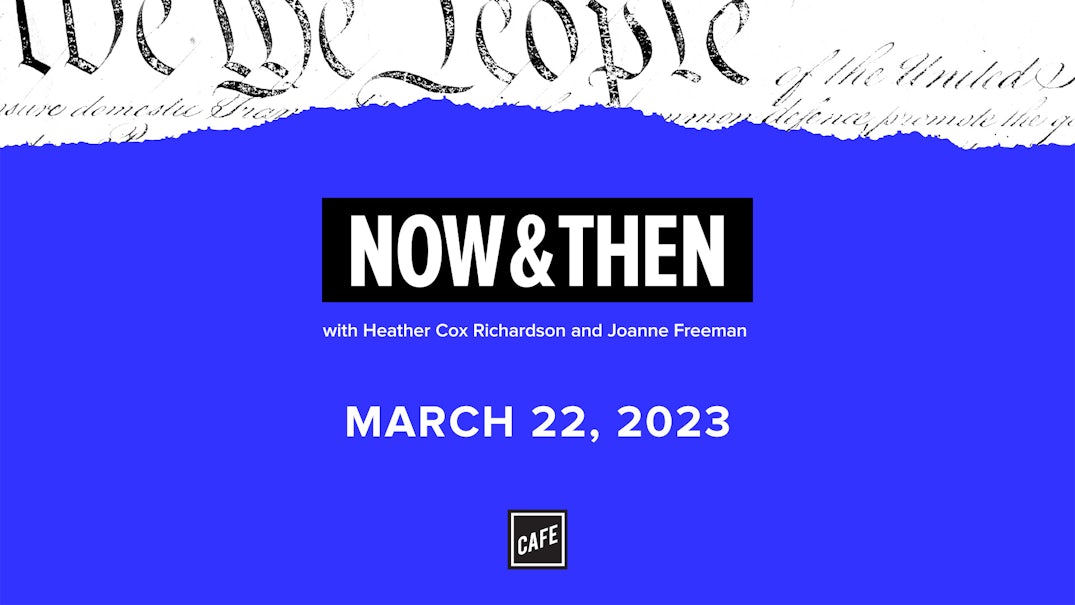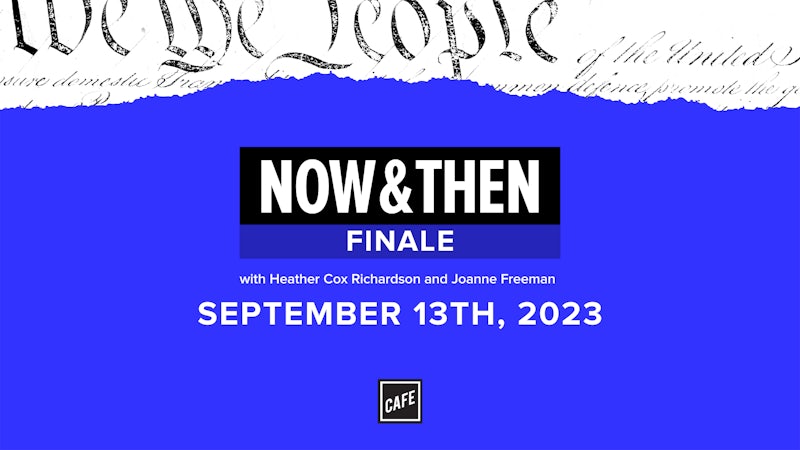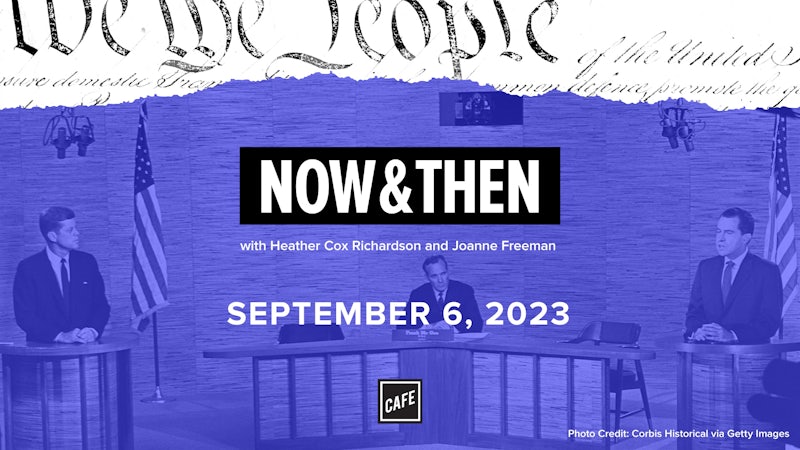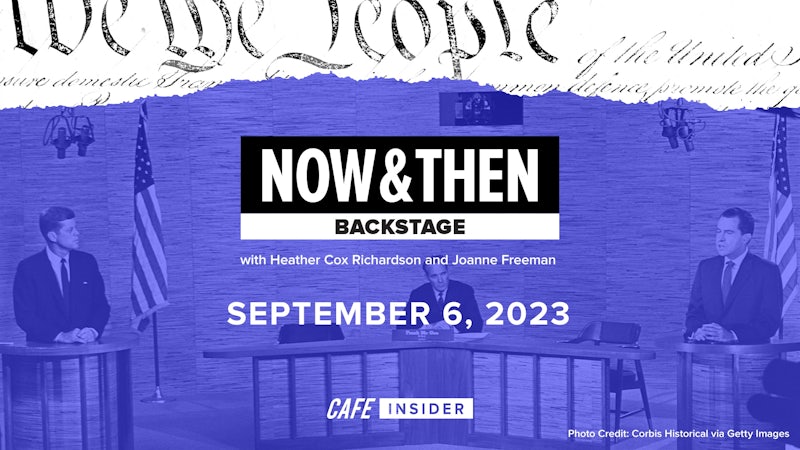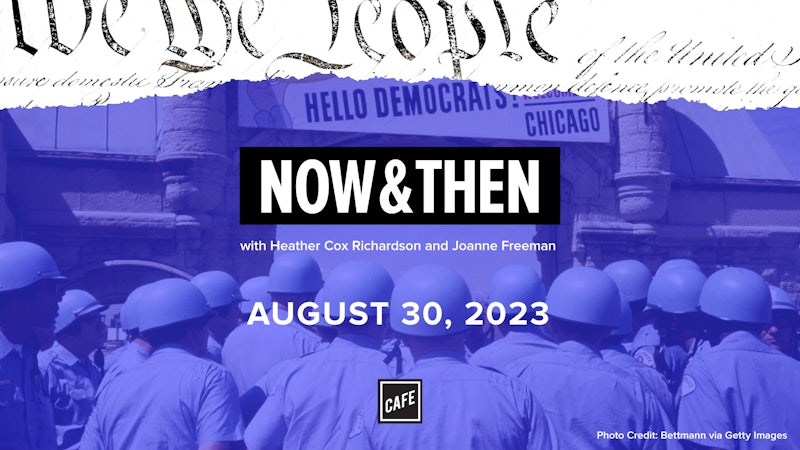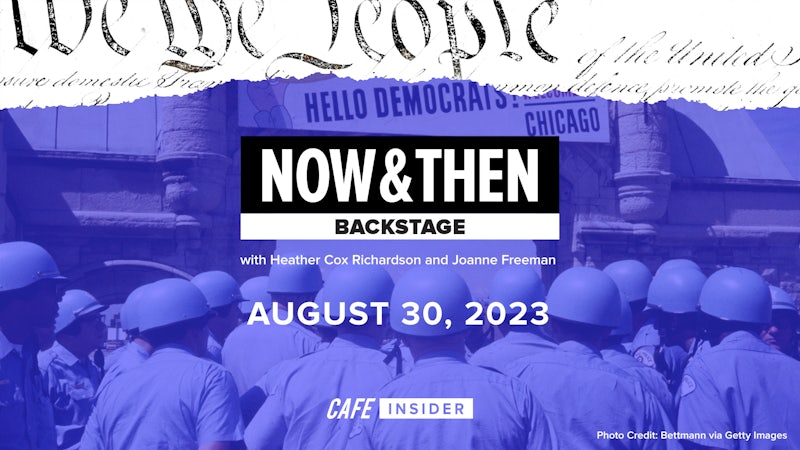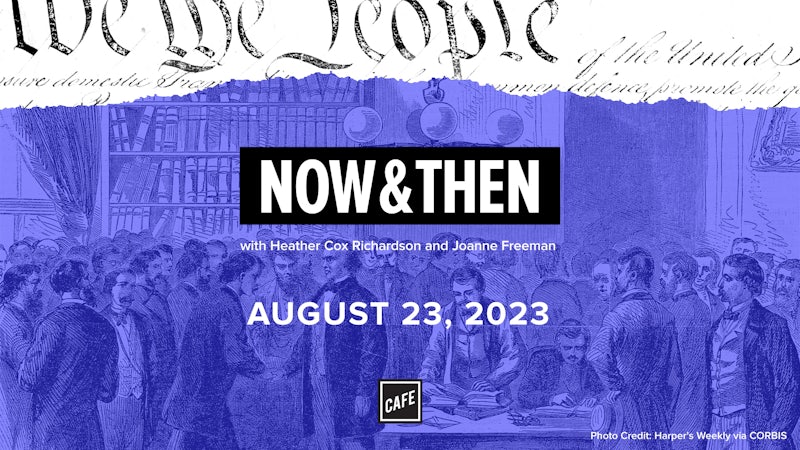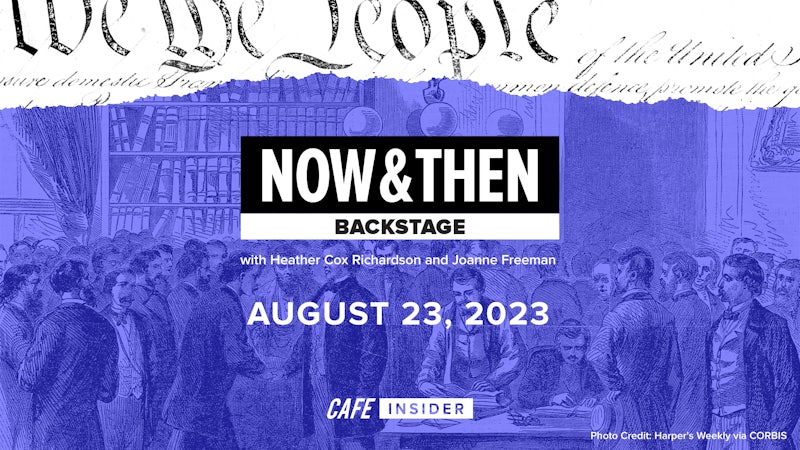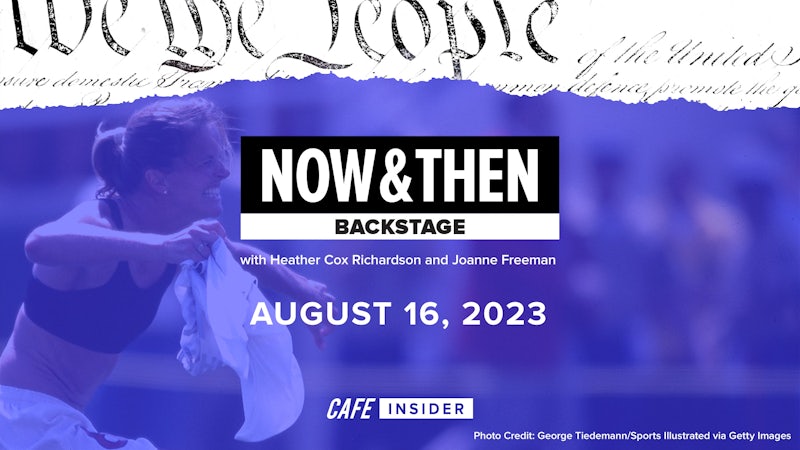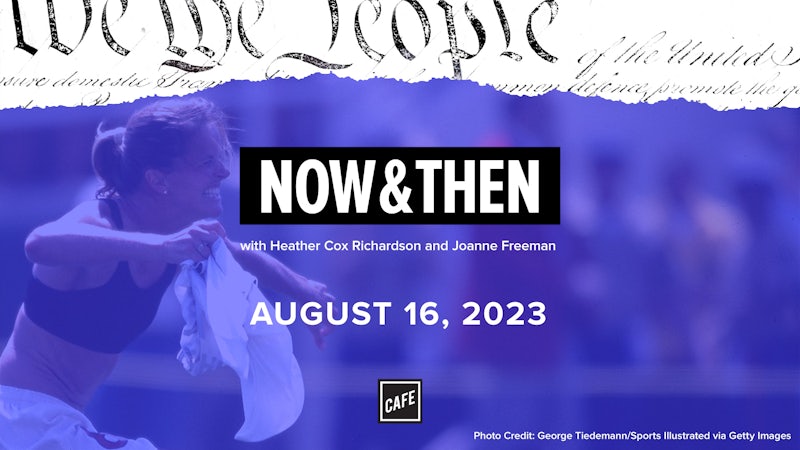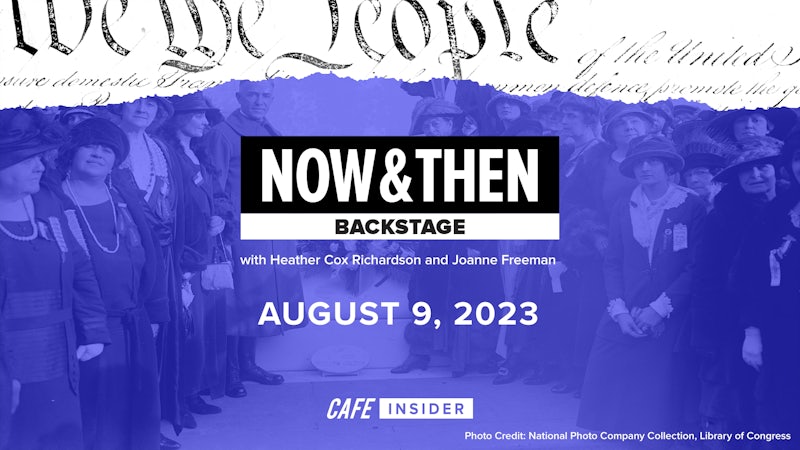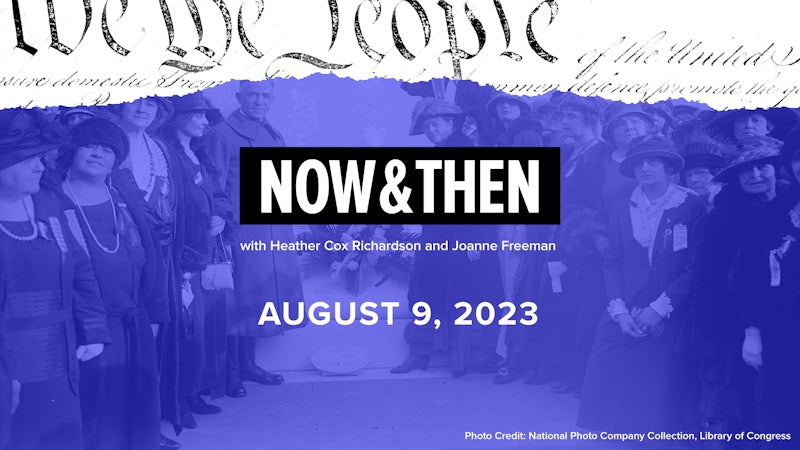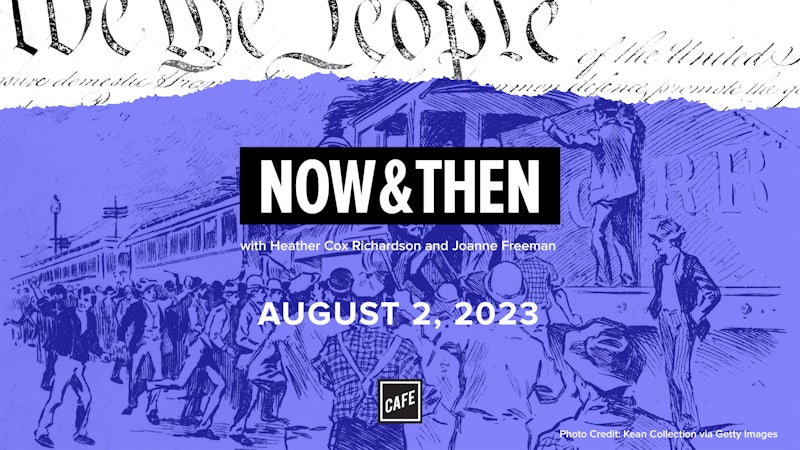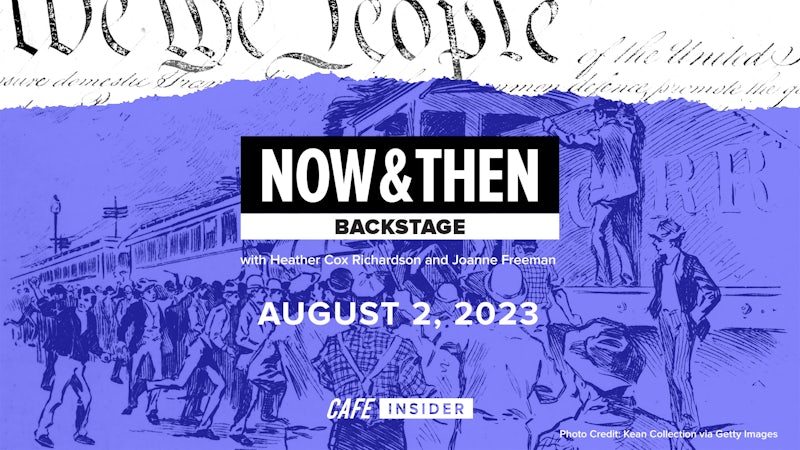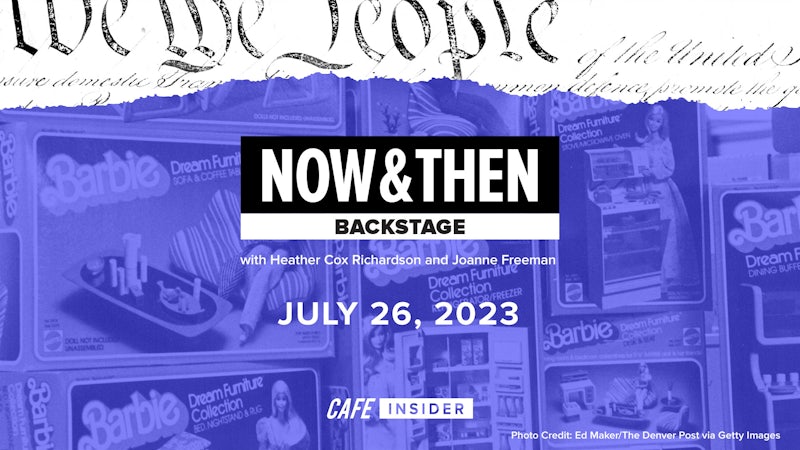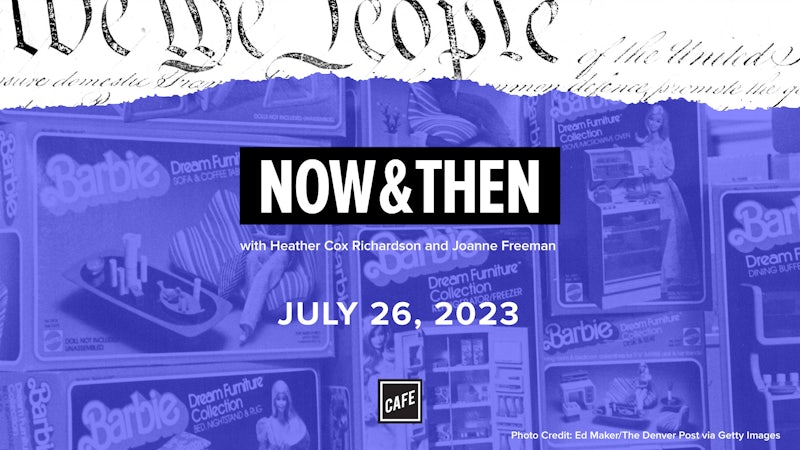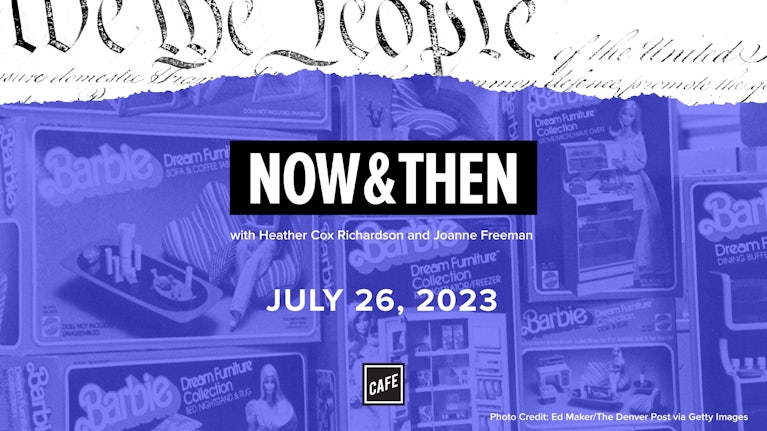Heather Cox Richardson:
From Cafe and the Vox Media Podcast Network, this is Now & Then. I’m Heather Cox Richardson.
Joanne Freeman:
And I’m Joanne Freeman. Today we’re going to be talking about a story that pretty much has been dominating the news recently, and that is the failure of Silicon Valley Bank. And then the subsequent implosion of Signature Bank and then some aftershocks where banks are in the news in one way or another. Now, on March 12th, the FDIC stepped in to protect the deposits of people who had money in both of those failing banks. But as of this taping, the financial sector is still having a good deal of anxiety and it’s unclear what’s going on or how far it will spread. Now, we’ve talked before in a number of ways about banks here on Now & Then, and about their role in national culture. Particularly, we’ve talked about banks as symbols of big money, essentially as ways of understanding dominance, dominant energy in American society.
Today, what we’re interested is sort of doing a riff on that. We want to look at the culture surrounding banks. What Americans have thought of banks over time, and what at any given time that reveals about American society.
Heather Cox Richardson:
I’m actually really excited about this, Joanne, because when people in the news talk about banks, they tend to focus on the actual movement of money and the actual issues behind things like the collapse of a bank. And those two things rarely come together. And when you think about it, one of the things that really jumped out to us when we were writing this episode was the actual edifices of banks. The fact that in most towns that you walk through, you can’t walk down a street without seeing at least one bank. And what does that mean to see those banks? And what do those banks represent not only about your money in it, but what do they represent about society?
So it’s kind of a marriage of my obsession with the way money moves in society and your focus on culture, and the reality that banks are incredibly important. I think it will help to look at the origins of banks and their edifices, and what they said about American culture before we get to the present. So it makes a lot of sense I think, to start back in your period with a very, very famous bank.
Joanne Freeman:
The second bank of the United States. Now the first bank of the United States was part of Hamilton’s financial plan that was controversial. There was a big question as to whether it was constitutional, since the constitution doesn’t say, yes, the national government can create banks. And that bank lapsed. There was a second bank of the United States created, and actually its creation was tied to the War of 1812. Not surprisingly during wartime, it becomes important to have a controlled, organized way for the government to manage funds. And Hamilton actually said that about the first bank. He said, “A national bank is a political machine of the greatest importance to the state.” So that was how he saw it as a political machine.
Heather Cox Richardson:
A society needs to have a stable money system, it just does. And so we’re always going to be up against the idea of how do you stabilize the financial system so that people can actually do trades and things, without at the same time creating super rich class that runs everybody else. And this moment, the first bank, but certainly the second bank screams this.
Joanne Freeman:
Well, and I will also say they aren’t necessarily trying to avoid creating a super rich group of people who control everyone else. The first bank, part of the logic behind it was rich people would invest surrounding that bank and that would essentially get them to invest in the country and the government. So there is that component that it’s quite deliberate in a way that banks and banks stock attract a certain kind of person whose money you want invested in the government.
Heather Cox Richardson:
So that they care deeply about this country as opposed to having their money invested elsewhere.
Joanne Freeman:
Correct. So the second bank, again, related to the War of 1812 and the fact that that suddenly makes the government’s ability to deal with finance in a more coherent and organized and predictable way important. Madison, who was president during the War of 1812 and was not really thrilled with the first Bank of the United States, suddenly realizes since he’s president during this war that a bank of the United States is a useful thing. So in 1816, Congress grants the second bank of the United States a 20-year charter. Gives the institution a $35 million capitalization. The first bank only had 10 million, so times have changed. And this bank had 25 branches across the country.
Networking of branches is one way in which you can sort of create the control inherent in a network. And 25 branches is a lot of branches in this early period of time. So even just institutionally, organizationally, the bank really mattered and had power.
Heather Cox Richardson:
Worth mentioning by the way, that it’s in Philadelphia. The fact that Philadelphia and later New York and Boston are the center of banking in the early republic is always worth remembering, because people nowadays think, oh, it’s New York, but in fact it’s Philadelphia in these early years where all the money is. I’m deliberately setting this up because I find the construction of the second bank of the United States and that edifice absolutely fascinating.
Joanne Freeman:
In 1818, the directors of the second bank announced a competition to design this bank. They wanted Greek revival style. They wanted this sort of grand Grecian columns. If you can imagine sort of classical ancient Grecian architecture, that’s in a sense what they wanted here. The directors of the bank described their desires for the bank in the Philadelphia Gazette by saying, “The building will be faced with marble, and have a portico on each front, resting upon a basement or platform of such altitude, as well combine convenience of ascent with due proportion and effect.” And this is the line that I thought was interesting, “In this edifice, the directors are desirous of exhibiting a chaste imitation of Grecian architecture in its simplest and least expensive form.”
And what I love about that is, when they put out an order for the furniture, for the chairs, for senators and representatives and the desks in Congress, it was the same description basically. It was really simple and plain and classical in style and clearly expensive looking. And it’s in that sense, Americans at the time would’ve said, ah yes, we’re going back to the Ancient Greece, Ancient Rome, classical style. We’re not beckoning back to Europe. We’re something apart and something different, and something plainer and simpler and more straightforward than the corrupt Europeans. But of course, that doesn’t mean they want this to look cheap. They want it to look simple and expensive.
Heather Cox Richardson:
So who designs it?
Joanne Freeman:
It’s designed by William Strickland. He actually is a pupil of Benjamin Latrobe who was the architect of the US Capitol. And he was inspired along the lines of what we’ve just said, by the Parthenon in Athens. It had eight huge Doric columns at the building’s front, and it opened in 1824.
Heather Cox Richardson:
Okay, so they have literally made the bank along the lines of the Parthenon, which is about worshiping god’s.
Joanne Freeman:
It is a temple of money.
Heather Cox Richardson:
It is a temple of money. And I also love that it’s the same concept as the government buildings. It’s just a lot smaller. It’s not a terribly big building. It’s quite a little jam, that whole area right there with all the historical stuff from Philadelphia. But it’s smaller than it feels like it ought to be with that kind of grand entrance, and the big columns, and the high ceilings and all that. All right, so we have here a monument to money and we have it looking like the buildings of democracy.
Joanne Freeman:
Yes, indeed. The third and most important director of the Second National Bank of the United States was Nicholas Biddle. And he’s from a very famous Philadelphia merchant family. He had a background in politics. He was a secretary to James Monroe when Monroe was ministered to Britain. He was a Pennsylvania state representative for a while. And as a representative, he clearly was in support of a national bank. And he was a big proponent of pushing for Greek architecture in the United States for many of the reasons that we’ve already said. He wrote in 1814… I love this quote, “The two great truths in the world are the Bible and Grecian architecture.”
Now, he was working, expanding, happily swimming along with the bank until 1829 when newly inaugurated president Andrew Jackson began to speak out against the Bank of the United States. And in December of 1829, he said during his first annual message to Congress that many Americans saw the bank as dysfunction itself. And that rechartering it should be very closely investigated by Congress. So Jackson said, “Both the constitutionality and the expediency of the law creating this bank are well questioned by a large portion of our fellow citizens. And it must be admitted by all that it has failed in the great end of establishing a uniform and sound currency.”
Heather Cox Richardson:
I have a huge flashbacks here because this is the first issue I learned about with my doctoral advisor. And I remember being like, the first bank of the United States, the second bank of the United States, what on earth’s going on? And Jackson wrote a number of very famous letters and messages to Congress in which he insisted that the bank represented the government favoring one set of people over another. And that his people, the people who were going to be Jacksonian Democrats, really resented the idea that the government was in their minds helping these very wealthy Philadelphians to become the people who stood in a temple of money.
Joanne Freeman:
Well, this was Jackson’s whole thing, I am the man of the people. And by man of the people, he of course meant white men.
Heather Cox Richardson:
Yeah, he took that position so he could win office.
Joanne Freeman:
Precisely.
Heather Cox Richardson:
He’s so problematic in so many ways. But the Bank of the United States is doing exactly what we are talking about here, it becomes a symbol… This building which is a great building and all that, but it becomes a symbol of the government itself. People who support it are saying, the government needs to stabilize our currency. It needs to make it possible to move money around and fight this war and do all that stuff. And Jackson is building his political future by saying, “No, you people are corrupt. You’re in the pockets of the government and this is a non-starter and we need to get rid of that bank altogether.”
Joanne Freeman:
And I’ll highlight what you just said, that this is a bank that allied in some ways with the government. It has rich people and helping out rich peoples’ back pockets and networking and all of this stuff that even to the present day, many people assume about banks. Here it is already at this early point in time, banks as bastions of wealthy people being benefited by banks and making money and networking and everything else. Now, everything that we’re saying here would suggest that anything about this bank of the United States is political. Nicholas Biddle was pretty assertive in saying, oh no, no, no this isn’t about politics. He wrote a letter to Pennsylvania representative Charles Ingersoll and said the following about himself and the bank, “I care for no party in politics or religion, have no sympathy with Mr. Jackson, or Mr. Clay, or Mr. Wert, or Mr. Calhoun, or Mr. Van Buren. I am for the bank and the bank alone.”
Well, then here comes Mr. Jackson who takes it into his head to declare that the bank had failed and that it ought to be superseded by some rickety machinery of his own contrivance. Mr. Jackson being the President of the United States, whose situation might make his ignorance mischievous, we said to work to disenchant the country of their foolery. And we have so well succeeded that I will venture to say that there is no man, no woman, and no child in the United States who does not understand that the worthy President was in great error.
Heather Cox Richardson:
The president of the US whose situation might-
Joanne Freeman:
Might make his ignorance mischievous.
Heather Cox Richardson:
Mischievous.
Joanne Freeman:
It’s a great statement.
Heather Cox Richardson:
All right, so Biddle says that we all know that we need the bank.
Joanne Freeman:
And in that spirit in 1832, he says, you know what? Let’s do that now. Let’s recharter the bank now.
Heather Cox Richardson:
And newbies like that is such a bad idea, Nicholas. Don’t do it.
Joanne Freeman:
He totally thinks it’s a bad idea. He knows a lot about banking in Hamilton. So he has a lot to say on this issue. So indeed he sort of in great confidence pushes ahead. So the house votes to recharter the bank and Jackson vetoes the rechartering of the bank in July of 1832. And in his veto message, he highlights the very fears that we’ve been talking about here, that the bank is creating financial divisions and defending the elite over anybody else. So he says here, that message, “It is to be regretted that the rich and powerful too often bend the acts of government to their selfish purposes. Distinctions in society will always exist under every just government. Equality of talents, of education or of wealth cannot be produced by human institutions.” Now that was rather sort of lofty veto language.
Privately, he’s a little blunter about what he feels and he actually, in this case talks about himself in the third person. It’s always a warning sign if you’re talking about yourself in the third person. He says, “Andrew Jackson would never recharter that monster of corruption. Sooner than live in a country where such a power prevailed, he would seek an asylum in the wilds of Arabia.” So he has rather strong feelings. And he removes federal deposits from the bank in September of 1833, deposits them in state banks around the country, become known as his pet banks because he’s empowering them at the expense of this national bank. And the next year Congress votes against rechartering the bank. So the attack on Biddle continues. In September of 1834, the Workingman’s Advocate published an anti-Biddle song, said to the tune of the Irish folk song, “Barney, Leave the Girls Alone.” I wish I knew that song.
Heather Cox Richardson:
I was going to say, please, please, please know how this goes.
Joanne Freeman:
I wish.
Heather Cox Richardson:
It sounds like you don’t.
Joanne Freeman:
I so wish. I tried, I really did. And I don’t know how it goes, but I will read you some of the lyrics because they’re just charming these lyrics. So the Workingman’s Advocate, “Mr. Biddle, let that bank alone, Mr. Biddle, let that bank alone. Why can’t you let that bank alone before you’re up a tree? Bring your books and vouchers true, show your debts and credits too. How many bribes, and tell us who and let the people see.” I wish I could sing that for you people. I truly do, and I have failed in my quest to sing.
Heather Cox Richardson:
I just quickly looked up what does it mean to say, before you’re up a tree. And that means you’re in trouble.
Joanne Freeman:
Yes.
Heather Cox Richardson:
Like up the creek without a paddle.
Joanne Freeman:
True. So the headquarters itself, the bank with all of its Greek pump, not surprisingly at this point becomes a target for opponents of the bank. Many of them referring to it searingly as the Greek temple in Chestnut Street. According to one historian, historian Alexander Boulton, he says that the United States Bank pictured in the newspapers of the day as a miniature Greek temple, began to symbolize in many people’s eyes a more sinister temple of mammon. So it really is a temple of money. After the charter expired in 1836, Biddle who still is insistent that banks are good, he’s still defiant.
He secures a Pennsylvania state charter, reconstitutes the headquarters of the US Bank of Pennsylvania and abandons his earlier cautious principles. And decides now that he’s on the attack to defend and support banks, he creates a partnership with the British Baring Brothers Bank. And it contributes to the panic of 1837. He also tries to corner the US cotton market. So basically he’s getting really aggressive, but also a little nervous and pushing, pushing, pushing to fight against this trend. So Biddle, although he’s fighting away here, he ultimately dies in disgrace at the age of 58 in 1841. The next year in 1842, Charles Dickens is on a tour of America, and he comments on the now rather somber look of the now shuttered second Bank of the United States.
He writes, “Looking out of my chamber window before going to bed, I saw on the opposite side of the way a handsome building of white marble, which had a mournful ghost-like aspect, dreary to behold. I attributed this to the somber influence of the night. And on rising in the morning, looked out again, expecting to see its steps and portico thronged with groups of people passing in and out. The door was still tied shut however, the same cold cheerless air prevailed. I hasten to inquire its name and purpose and then my surprise vanished. It was the tomb of many fortunes, the great catacomb of investment, the memorable United States Bank.”
Heather Cox Richardson:
Perfect, just perfect. This idea is this great temple to a tomb.
So the next thing we wanted to talk about might come as a surprise, because so much of our late 19th century culture is wrapped around the idea of train robberies and outlaws. And I know when I first learned about this, it never occurred to me to wonder what on earth they were robbing. They’re robbing the trains, but I ride the train every week and what would you rob? So they are in fact robbing trains. But they’re robbing trains because in the middle of the 19th century and especially after the Civil War, we get the rise of express companies.
Now, you probably have never thought about the fact that American Express, for example, you think about it as a credit card or whatever, was actually a company started in the 19th century along with a couple of other really famous ones to move things from one part of the country to another. Until you get the idea that the United States Postal Service can carry packages, how else are you going to get things from one place to another? Well, who really needs to ship stuff? Bankers. So the express companies are going to take responsibility for moving bags full of money, essentially. And you know about it on wagons of course, but you also know about it on trains. And so the image of money on trains, thanks to express companies, is going to turn out to be pivotal in American culture.
Joanne Freeman:
Now, the first robbery of a moving train came in October of 1866 when brothers John and Simeon Reno stole $13,000 from an Ohio and Mississippi railroad train in Jackson County, Indiana. And the two men entered a car that was shipping money through the Adams Express Company, a freight and cargo company that had been part of the Pony Express system, yet another way in which things are being moved from one place to another. And it was just transitioning to trains. The Renos wore masks, they carried guns as you think train robbers should. They emptied one safe, they threw another one through the window of the train and then they leapt off of the car.
Heather Cox Richardson:
So hang on just a second, $13,000 in 1866. This is a time when a good skilled worker in an agricultural place like Indiana could make about $30 a month. So this is a gazillion dollars. And you think of what it means that you can go onto these trains which are somewhat unguarded at this point, and just take safes and throw them out the window or take bags of money. And what that says about movement, and about opportunity, and about the law and about money in this period.
Joanne Freeman:
It captures this moment when the railroads are really taking off and that they’re uniting the country. And it in a sense is a step in the modernization of the nation being brought together by technology in this way. And in a sense is perfectly fitting that as that is happening, and as money begins to be part of that great networking of the country, you have people who immediately pounce on that as well and begin a new form of robbery, train robbery. It makes perfect sense that all of those things are happening at the same moment in time.
Heather Cox Richardson:
And because of the timing of this, it’s going to have political repercussions as well, because who’s got the money in 1866? For the most part, the people who have money and who run these express companies are going to be Republicans after the war. So quickly the idea of robbing banks which is criminal and people die, is going to be associated with fighting back against this hated government on the part, especially of southern Democrats. So walk us through Joanne, what the express company does, because you can’t have people just essentially hopping on a train and stealing all your money.
Joanne Freeman:
No, that would be bad. So the Adams Express company hires the Pinkerton Detective Agency, which was founded in 1850. Was really rising in prestige at this moment, not surprisingly, given some of what we’re talking about here. And these Pinkerton agents quickly identified the Renos as the people responsible for the train robberies. Now, the Pinkerton agents chase the growing Reno gang for two years. The gang meanwhile just continues to commit these brazen robberies of American Express cars, on moving trains while working apparently on an unsuccessful scheme to assassinate Alan Pinkerton, the leader of the Pinkerton Detective Agency.
Heather Cox Richardson:
And Pinkerton writes books about it. So Pinkerton’s all about advertising himself. And as we’re going to see, this becomes a central part of American culture, in part because it’s got all the elements of… Oh, I don’t know, a good movie
Joanne Freeman:
And other things as well, which will come to shortly because obviously the drama and the society-wide implications of this are going to take on sort of folkloric proportions in time,
Heather Cox Richardson:
Folkloric proportions.
Joanne Freeman:
You’ve now realized the degree to which I will get halfway through saying something, and then I’ll realize I’ve backed myself into a corner and I’ll find some way to come out of it. So folkloric proportions, I got folklore and then I couldn’t figure out how to pull my way out. So folkloric proportions. So in 1868, members of the Reno gang escaped to Canada. They’re extradited back to the United States. They end up being lynched by an angry mob while they’re in federal custody. And this kind of vigilante end to this particular gang’s reign of terror sparks a brief international incident between the United States and Canada. But more important here is the fact that the Reno gang sets off a trend that involves increasingly targeting bank train cars. And becoming ever easier because the amount of train travel is rising throughout this period, particularly following the completion of the transcontinental railroad in 1869.
In 1877, outlaw Sam Bass and his gang robbed a Union Pacific train in Big Springs, Colorado. The train was carrying newly minted $20 gold pieces from the San Francisco mint back to the East Coast. But what’s interesting here is that many Americans sided with the bank robbers over the banks and the cargo companies that they were attacking, arguing that the robbers were modern day Robin Hoods, praising their ingenuity and their bravery. So for example, Sam Bass became the subject of a folk song, The Ballad of Sam Bass, that celebrated his evasion of the Pinkerton agents and Texas Rangers during his flight. And The Ballad of Sam Bass actually has been recorded, ethnomusicologist Alan Lomax, who did this amazing work of wandering through the country and recording these really traditional folk songs, recorded this ballad in the 1950s.
Heather Cox Richardson:
What that story highlights is that theme that the express companies and the train companies with whom they’re working represent big money. They represent the Republicans who at this point are acting for industrialists in Congress. And that the idea that these guys are criminals, they are robbing people, which means they’re going in with guns, sometimes taking lives, stealing from people. But they become sort of lionized as the little guy standing up against big money.
Joanne Freeman:
Big money, big institutions, rich people, elite networks, all of the things that get lumped together as quote unquote, “bad guys at so many points in American history”. So these bank robbers or these train robbers who essentially are bank robbers, become heroic for attacking these institutions. They become folk heroes,
Heather Cox Richardson:
They become folk heroes. And we can’t let this go by without mentioning Jesse James. Jesse James becomes really the national symbol of this moment. He and his brother Frank were part of Quantrill’s Raiders in Missouri during the Civil War. And this is an important part of his past because Quantrill’s Raiders were gunmen. They would ride into a town and they would shoot with six shooters from either side of their horses. And they would ride out before the townspeople could get their guns. And so they were really, really hated. Missouri was almost evenly divided between union families and Confederate families. And Quantrill’s Raiders were considered just criminals basically.
You didn’t go in and shoot up a town without a little bit of warning so that somebody had a chance at fighting back. So after the war, even though theoretically there’s an armistice and they should be able to go home, somebody actually shoots Jesse James on his way home because he’s a former Confederate. And he lives obviously. He and his brother Frank go on to become train robbers. But they argue that they are robbing the trains not because they’re criminals, which they absolutely are, but because they’re being persecuted by the government. Because during the war, Missouri is controlled by the Republican Party. And in 1864, they put through a constitution called the Drake Constitution or the Draconian constitution to people who really hate it. That basically says that if you have ever aided a member of the Confederacy in any way, you can’t vote, you can’t sit in a jury, you can’t be a teacher, you can’t be a minister. So what they say is that we’re Democrats and we aided the Confederacy.
And even though the southern states have all been readmitted to the union after 1870, we in Missouri are still under this constitution which says we basically can’t work, we can’t be part of society. So they start to say that their robberies are part of this really political battle between them and this grasping government. In 1873, the James gang joins up with the younger gang. There’s actually a lot of mixing in Missouri between the gangs in this period because of all the troubles from the war, and because Missouri is enormously chaotic in this period. In 1873, they steal $3,000 from a Rock Island Line train in Iowa and they were wearing Ku Klux Klan masks when they did it. Very much we are Democrats, we are former Confederates, we also don’t want you to know who we are.
And they repeatedly would try and set up their robberies in such a way that it looked as if they were favoring Democrats or Confederates. So they would steal all the valuables from the Republicans on the train for example, or at least that’s the way it showed up in newspaper reports. Or they would make sure that they wouldn’t steal from a Confederate widow who happened to be on the train.
Joanne Freeman:
But that’s a point worth noting, which is whether or not that actually happened. That is how it’s showing up in newspapers. So the mythologizing of and politicizing of what’s happening is happening all over the press. And that may have actually happened, but the fact that it’s written up that way is the most important part.
Heather Cox Richardson:
So if this meant that the state of Missouri went back to the Democrats, that was just fine with the James’s. And both Frank and Jesse James were very good at playing the media. At one point, Frank James said, “I know people called Missouri the state of bushwhackers and outlaws. They said it was the home of the James boys, and life and property were not safe. So the Republican immigrants went through Missouri without stopping. The result is that Missouri is democratic. Her people have been forced to depend on their own resources.” Now, they went on to continue train robberies that got more and more extravagant as they got better and better at it. And they became for a number of Southerners and Democrats who really resented the Republican government, a symbol of the little guy pushing back. And finally a man named John Newman Edwards, who was a former Confederate soldier and had a very popular newspaper, The Kansas City Times, begins to argue that in fact the James gangs were simply avenging the Confederacy and they were pushing back against the spread of Republican power through railroads and the banks.
Edwards said, “Since 1862 the government has been robbing, so has its officers of high and low degree, so has every administration in every southern state. So did the administration of Missouri, so have the national banks, the tariff, the custom house, the Indian agents, the railroads, the cabinet officers grant himself. To stop it, to break up private as well as official robbery of all kinds, it is only necessary to break up the radical party. For this Augean stable there must be another Euphrates.” Well, and of course the Republicans, especially the Republican governor of Missouri is desperate to stop the James gang. And finally, the governor of Missouri begins to work to empower other people to basically kill Jesse James.
And finally, James is killed in 1882 when a member of his gang Robert Ford, shot him while he was adjusting a picture on the wall and while he was hiding under the name of Howard. So Robert Ford becomes the dirty little coward who shot Mr. Howard.
Joanne Freeman:
When we started talking about this episode, I learned this in elementary school and it has stayed with me like since third grade. And it has been sitting in my brain with no purpose. And I didn’t even know until this moment we were preparing for this episode why Mr. Howard is in the song, that was James’s alias at the time. So this is the song I learned in third grade. You’ll see it highlights all of the themes we just talked about here, and the ways in which James and other such train robbers are made these heroes fighting the system, taking from the rich, giving to the poor. So here is the song I remember from third grade, (singing). Now that’s a 19th century folk song that just sums up exactly what we’re talking about here, as Americans celebrating these people for everything that they were fighting against.
Heather Cox Richardson:
But the idea that the robbers are somehow helping the community is… And therefore-
Joanne Freeman:
Robin Hood.
Heather Cox Richardson:
Yeah, Robin Hood.
Joanne Freeman:
Taking from the rich and giving to the poor.
Heather Cox Richardson:
…is deeply embedded in the way they made it into popular culture. But I really want to emphasize with this idea of the train robberies. This really, really matters in terms of the way we think about outlaws and we think about money and who has it. Now at least because what is the first popular movie in American society? The Great Train Robbery. And The Great Train Robbery is absolutely based on the idea of a train robbery by a man named Robert LeRoy Parker. He’s from Wyoming and he is better known as Butch Cassidy.
Joanne Freeman:
Butch Cassidy.
Heather Cox Richardson:
In August of 1900, Butch Cassidy and the Wild gang attacked a Union Pacific Railroad train near Table Rock in Wyoming. They uncoupled the passenger cars from the rest of the train. They blew up the safe in the mail car. Now, that moment became immortalized in the 1903 film, The Great Train Robbery. Although the idea of train robberies had been part of Wild West shows ever since Wild West shows had been. This was absolutely stock. And the scenes in The Great Train Robbery, which you can watch by the way on YouTube, it’s not very long, but that silent film was groundbreaking. It is a series of chronological scenes over 12 minutes.
And the story it tells of the robbers going onto the train, getting the safe, blowing the safe, and the posse being gathered and riding out after them shows all sorts of new kinds of techniques in the film history. Like cross-cutting for example, showing different actions in different locations and brings this idea of the robbers to the screen. And it started the whole genre of Western films, which is going to be the heart of filmmaking for a very long time even though it was actually filmed in New Jersey.
Joanne Freeman:
You’re talking about the special effects. And this is particularly striking given the way in which we’ve been saying all along here when talking about train robbers, bank robbers, of how these are actual criminals potentially even sometimes killing people, shooting people, stealing, committing crimes, and yet they’re heroic. That in this movie, The Great Train Robbery, one of the big special effects that was talked about was a pistol is aimed point-blank at the screen and fired. Now obviously that would’ve been like highly dramatic. Even now actually that would be something that would be noteworthy, in 1903 it’s very noteworthy. But think about… To me what’s striking about that is the image of that, that’s these people who in some ways or another are seen as heroes.
Heather Cox Richardson:
And in that final scene, which I have to say even still is startling. If you have never seen a film before, and we’ve talked about this a lot on this podcast, when something is new and you’ve never seen it before, you don’t really know what to make of it. And people hit the ground of the theater. When the gun turned on them and then it went off, people did not know whether or not there was going to be a bullet coming out of it right at them. And it feels really immediate. And that power of money and the fights over money becoming that visceral to the members of an audience, it’s about control of the funds of the country and the relationship between people with money and people without money and how one controls the other. And then we have the 1920s.
Joanne Freeman:
And then we have the 1920s. So before the depression, the US reaches its sort of peak number of banks. In 1922, there were 30,000 banking institutions in the country and particularly urban banks. They were made sort of these architectural castles. These vast, huge, deliberately impressive marble and limestone structures that were built to impress, were built to draw in potential depositors and to represent the spirit of that moment of investment, of big money, of prosperity, of the nation booming. It was a real exemplification of 1920s banking exuberance.
Heather Cox Richardson:
I love these banks. They feel like churches to me. They tend to have vaulted ceilings. This is the art deco periods, so many of them have just spectacular art deco detailing on them. But one of the things that always jumps out at me is what it symbolized to have this church, if you will, not limited to Chestnut Street in Philadelphia where only the rich guys get to go. But you could go in there with your little pocketbook and you could be part of this idea that American finance was building the world and you were a part of it. Let’s walk through some of those.
Joanne Freeman:
I want particularly to hear about the one that you saw recently, because when we were talking about this episode you mentioned one in Detroit that you’d been in and how impressive it was.
Heather Cox Richardson:
The building that I went to was the Guardian Building in Detroit, somewhat by accident to be honest. We had time in an evening in Detroit and it was really cold and there wasn’t a lot to do for as much time as we had. So we were just looking at things in the area and somebody said, “Oh look, here’s the Guardian building.” And I said, “What is that?” And they said, “I have no idea but it’s open. Let’s go look at it.” So we did. Turned out to be spectacular. It was a trust bank rather than a savings bank. It’s finished in January of 1929. It was built with tan mankato brick and it was trimmed in terra-cotta. It is 496 feet, 40 stories. It was an art deco building. And what really jumped out to me about it was that it really featured color.
So many of these art deco buildings really focus on sort of the clean lines of art deco and the shapes of art deco without really focusing on color. And for this particular building, an artist from New York, a man named Ezra Winter, put on one side of one of the hallways a mosaic map of Michigan that showcased all the top industries and resources at the time. The main lobby is 150 feet long and it has framed ceramics of Mary Chase Perry Stratton, who created hexagonal shapes of gold, orange and turquoise. And the main entrance has relief sculptures called safety and security who are sentinels, and they were carved by a famous sculpture. So the look of it today is very powerful. The colors are absolutely still vibrant.
Joanne Freeman:
It’s still a temple of a sort.
Heather Cox Richardson:
Yes, quite deliberately like a temple. And with that color, it brings a vibrancy of color to it that was like nothing I’ve ever seen before. The building’s architect talked about how important color was and he said, this is Wirt C. Rowland saying, “We no longer live in a leisurely age. The impression must be immediate, strong and complete. Color has this vital power.” And I am 100% on board with that, almost 100 years later I walked into the lobby and was just absolutely blown away by the overall impression of these high ceilings and the color. And one of the mosaics actually said something that jumped out at me as important for what we’re talking about today. This beautiful, beautiful mosaic that says… Of the original company for which the building was built, this is 1928, “Founded on principles of faith and understanding, this building is erected for the purpose of maintaining and continuing the ideals of financial service, which prompted the organization of this institution.”
Joanne Freeman:
Ooh, that’s the angels heralding. While you were seeing this sort of temple of money, a friend took me into a bank, said, “Have you ever seen Apple Bank?” And I thought, well, Apple Bank, “No, I have not seen Apple Bank.” But originally it was Central Savings Bank building on the upper west side. And sure enough, the outside is not particularly auspicious. But when you walk inside, very much along the lines of what you’re describing, huge vaulted ceilings and marble and limestone and words up sort of above you, thrift, prosperity, the sort of things that you’re supposed to literally bow down to and celebrate as part of America. It was amazingly impressive. From the outside you would never know that that was there. So I poked around a little bit afterwards to try and figure out really what that was before it was Apple Bank. It was part of the Central Savings Bank, but it was a branch office.
So interestingly, before 1923, savings banks in New York City could only have one building. And in 1923 there was a law passed that said you could have branches. This was a really early branch bank, this vast sort of castle of money which was deliberately made that way. A 20th century commentator in the New York Times said to call what later becomes the Apple Bank for savings, a neighborhood branch bank is like calling Grand Central Terminal a commuter train station. It’s amazingly impressive. And in the same way as what you were just describing in Detroit, Heather, these are such powerful, visceral statements of this moment of celebrating money, prosperity, the power of the nation to a degree that you are sort of awed when you walk inside of these buildings.
Heather Cox Richardson:
Well, so one of the most discussed bank palaces in the 1920s was the Bowery Savings Bank, which was near Times Square. It opened in 1923 and was designed by York & Sawyer, the New York firm. And the building itself was 18 stories. It was an Italian Romanesque revival building. It had a 70-foot marble and limestone central banking area supported by six columns of different marble colors. And the reason I wanted to highlight that was because an architecture critic named Charles Loring in June of 1928 in architectural forum, said this was a design that made personal depositors feel they were part of something thrilling. Loring wrote, “No wonder the happy authors sang the song of savings in the walls and floors and counters using the richest of all conceivably rich marbles. It is also elegantly superlative that symbolism finds its last expressive bit in the reveals of the interior arches, where the toiling depositor can gaze on centaurs, hippogriffs, Pegasus and Gleason lions with foliated tales. Here is a castle in the clouds brought to earth, and the ticket of admission is only a stiff little deposit book.”
Joanne Freeman:
He goes on to say there are nearly 200,000 depositors in this mutual bank. And each one as he enters can say, “This was built for me. Herein am I privileged.”
Heather Cox Richardson:
And the thing that jumps out to me about the 1920s banks and how many of them there were is that, I didn’t use the word church casually. They feel like it’s something bigger than an individual. And they feel as if you question it, you are somehow being sacrilegious. And the idea in this period in the 1920s that everything was going to be solved by the American economic system is really embodied by those giant buildings. And then of course the crash hits. So the Guardian building is finished in 1929 and just three years later it goes into receivership. They can’t pay the lease on the building and it ends up during World War II being repurposed to be the command center for the US Army Wartime Ordinance production program, which is going dramatically to change the way that the entire financial system is run in America.
And also it’s going to change dramatically the idea that what’s really going to make America work is no longer financiers, it’s going to be the government. And it’s going to be individual Americans working together through the government. So there’s this weird like, here we are all part of this worshiping society and then it all falls apart. So that brings us to SVB, and today’s banks and what they say about the relationship between money and power today.
Joanne Freeman:
Now, it’s interesting because we’re curious to see… Given all of the news about Silicon Valley Bank to see what that bank looked like. And we were all struck by the fact that it’s very simple. It almost doesn’t look like a bank, particularly compared to what we’ve just been describing. It could be anything. There’s nothing about it that’s particularly noteworthy. And to me, what’s striking about that is it mirrors to me my image of what it would be to work in Silicon Valley, which would be these people who are immensely wealthy, all wearing jeans and t-shirts in their offices. It’s this modesty of wealth and the fact that these are people of potentially at least that for a time, tremendous power and wealth who can afford not to need to impress because of who they are.
Heather Cox Richardson:
Well, and I would add that the wealth in this moment is not visible. It’s all operating on wires and things behind the scenes. So blending in, especially in a time where you have cyber currency, where you have all these different new forms of things that are invisible to most people, it only makes sense to have the edifice itself look kind of like a shoe store really.
Joanne Freeman:
Right. It’s power, but the power in a sense is the very fact that it isn’t screaming out that it has power. It’s that it’s behind the scenes. It’s about the fact that it’s networks of people engaged with each other. Not only not needing to scream out that they have power, but really not very interested in getting that kind of attention drawn to what they’re doing involving power and vast amounts of money. And finding ways to embed and control and make permanent that kind of financial stability, not necessarily for the nation but for themselves. So in that sense, most of those banks fall into the non-descript zone. They’re not these older sort of temples of money.
They’re really modern structures that are just there along with stores and other things that are happening, which to me, very much is of our current moment. Very much is of a time when big money is not necessarily something we marvel at. We assume that it’s there. We walk by it all the time as part of our lives, but we don’t necessarily have control or a hold on it.
Heather Cox Richardson:
Well, and so much of it now is done on screens. They’re done moving numbers that you can’t see. The fact there isn’t an edifice, I think also contributes to the sense in this moment that things are happening in secret. That there’s somebody moving stuff and we don’t know who’s doing it, and what’s going on, and who’s responsible. And makes SVB and what’s happening I think a window into American culture just as the edifices of the 1920s were, the train robbers were.
Joanne Freeman:
The ways in which all of these things across time embody in visual ways, American views about business, power, money, and where power lies, but it’s part of the fun of studying the culture of anything. Is because it brings to life and often to visual form things that you take for granted or don’t think about. And when you stop to think about them, you really start to get the power of the message behind them.












